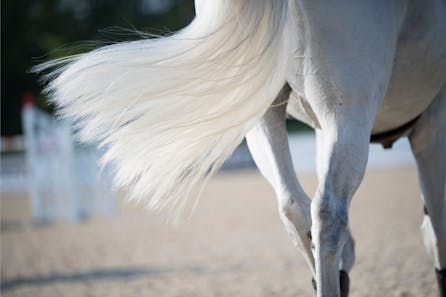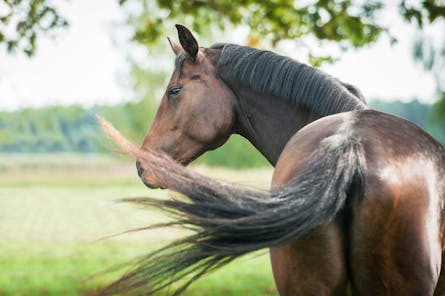
horses Tail Info...
- Anatomy:
The tail is the elongated extension of a horse's spine, consisting of a series of vertebrae covered with muscles and tendons. The tail hairs, or tail "mane," grow from the base of the tailbone and are usually longer and coarser than the body coat.
- Function:
The tail serves several purposes for horses. It helps with balance and stability during movement, particularly at high speeds, such as during galloping. Additionally, the tail can be used for communication with other horses. A raised or swishing tail can indicate excitement or agitation, while a relaxed tail often signals contentment.
- Grooming:
Grooming the tail is an important part of horse care. This includes combing or brushing to remove dirt, tangles, and debris. Tail care can also involve washing and conditioning the tail hairs to keep them clean and healthy. Some horse owners choose to trim or thin the tail for practical or aesthetic reasons.
- Appearance:
The tail's appearance varies among horse breeds and individuals. Some horses have long, flowing tails, while others have shorter or docked tails. The tail's colour and texture can also differ, with variations from straight to curly, and from coarse to silky tail hairs.
- Care and Protection:
Protecting the tail is essential to prevent damage. Horses may rub their tails, causing breakage or hair loss, so addressing the root cause of the rubbing, such as parasites or skin irritation, is important. Tail wraps or bags can be used to protect the tail hairs from rubbing, dirt, and damage. Proper grooming and tail care contribute to the overall health and appearance of the tail.
Horse owners and caregivers should be attentive to the needs of the tail as part of overall horse care, ensuring that it remains clean, free of tangles, and well-protected from environmental factors and potential damage. Proper grooming and tail care help maintain the health and appearance of a horse's tail.
Did you know....
- Horses can communicate with their tails in several ways. For example, a horse may swish its tail rapidly to indicate annoyance or agitation, while a gentle flick of the tail may be a sign of relaxation.
- Tail docking, the practice of cutting or removing part of a horse's tail, is illegal in some countries and controversial in others. In some equestrian disciplines, such as dressage, a neatly trimmed and styled tail is considered desirable and can be a factor in competition judging.
- Like a horse's mane, a horse's tail requires regular grooming and care to prevent tangles and damage. This can include brushing or combing the tail, trimming any split ends, and using detangler or conditioning products as needed.
Here are more products to use for your horses tail...




